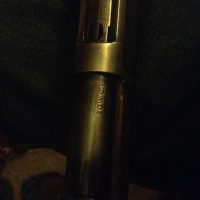Funny thing I never really noticed the 30 WCF on the barrel until you mentioned it but its there!
It’s kind of an interesting part of firearms history. Many think of Remington as Winchester’s main competitor, but for a long time, thier biggest competition was Marlin. Especially in the lever action rifle space.
So Winchester, in 1894/95 comes out with the trade-named .30 Winchester Smokeless, the brass of which was headstamped .30 WCF.
Marlin must have very quickly realized that Winchester had hit a home run with the WCF because they started working on Marlin’s own version of the chambering for the Marlin Model 1893 just a few months after Wichester rolled out the WCF.
There was no way that Marlin was going to reference a Winchester trade name in their own rifles, they never did that and they weren’t about to start now. Marlin didn’t make ammo, so they went up the road to Union Metallic Cartridge company (UMC) and had UMC whip up Marlin’s own version of the .30 WCF. They named it using the old military convention of using the bullet diameter followed by the grains of powder.
But this got a little wierd. Since this all happened shortly after the “transitional period” from black powder to smokeless, I’m surprised the name didn’t backfire on Marlin / UMC. Because it takes fewer grains of smokeless powder compared to black powder, the .30-30 must have seemed relatively weak next to the old black powder designated loads like the .45-70, .45-90, etc. But apparently this didn’t slow things down a bit because whether you called it the .30 WCF or the .30-30, or the .30 Winchester Smokeless, it became one of the most successful cartridge offerings ever produced.
And it had an exceptionally long life compared to other transitional cartridges. It seemed like the road from black powder to smokeless was fraught with danger and so many of the chamberings that came out in this period were obsolete just a decade later.
We in the late 20th century were not able to replicate this feat until the short magnum craze in the last years of the century.
Grouse


